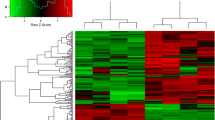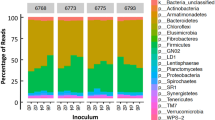Abstract
We have set up an ex vivo ovine ruminal model, which can mimic the multicellular process to explore the early steps in Salmonella typhimurium lipopolysaccharide (LPS) stimulation using RNA-seq technology. Ovine ruminal explants were collected for histological and transcriptional analysis and supernatants collected to quantitate lactate dehydrogenase (LDH) enzymes. A total of 8 and 523 genes were significantly over-expressed between LPS-treated and control tissues at 6 and 12 h, respectively. However, six and seven hundred and thirteen genes were substantially repressed between the aforementioned tissues, correspondingly. Key genes up-regulated in response to the addition of LPS were tumor necrosis factor (TNF), interlukin (IL)-1 beta(b), IL-6, IL-8, IL-17B, IL-19, MMP-1, MMP-3, and integrin alpha 2 (ITGA8, 9). This study shows for the first time that galectin-1 is up-regulated in an ex vivo ruminal segment model exposed to bacterial lipopolysaccharide following 6 h of incubation. The ruminal segment model has been shown to be a suitable tool to study the bacterial lipopolysaccharide effects on the ovine ruminal tissues prior to in vivo assessment.




Similar content being viewed by others
References
Alvarez Rojas CA, Scheerlinck JP, Ansell BR, Hall RS, Gasser RB, Jex AR (2016) Time-course study of the transcriptome of peripheral blood mononuclear cells (PBMCs) from sheep infected with Fasciola hepatica. PLoS One 11(7):e0159194. https://doi.org/10.1371/journal.pone.0159194
Ashraf GM, Rizvi S, Naqvi S, Suhail N, Bilal N, Hasan S, Tabish M, Banu N (2010) Purification, characterization, structural analysis and protein chemistry of a buffalo heart galectin-1. Amino Acids 39(5):1321–1332. https://doi.org/10.1007/s00726-010-0574-7
Ashraf GM, Banu N, Ahmad A, Singh LP, Kumar R (2011) Purification, characterization, sequencing and biological chemistry of galectin-1 purified from Capra hircus (goat) heart. Protein J 30(1):39–51. https://doi.org/10.1007/s10930-010-9300-2
Ashraf GM, Perveen A, Tabrez S, Jabir NR, Damanhouri GA, Zaidi SK, Banu N (2015a) Altered galectin glycosylation: potential factor for the diagnostics and therapeutics of various cardiovascular and neurological disorders. Adv Exp Med Biol 822:67–84. https://doi.org/10.1007/978-3-319-08927-0_10
Ashraf GM, Perveen A, Tabrez S, Zaidi SK, Kamal MA, Banu N (2015b) Studies on the role of goat heart galectin-1 as a tool for detecting post-malignant changes in glycosylation pattern. Saudi J Biol Sci 22(1):85–89. https://doi.org/10.1016/j.sjbs.2014.07.008
Ashraf GM, Perveen A, Zaidi SK, Tabrez S, Kamal MA, Banu N (2015c) Studies on the role of goat heart galectin-1 as an erythrocyte membrane perturbing agent. Saudi J Biol Sci 22(1):112–116. https://doi.org/10.1016/j.sjbs.2014.09.018
Bansal D, Ave P, Kerneis S, Frileux P, Boche O, Baglin AC, Dubost G, Leguern AS, Prevost MC, Bracha R, Mirelman D, Guillen N, Labruyere E (2009) An ex-vivo human intestinal model to study Entamoeba histolytica pathogenesis. PLoS Negl Trop Dis 3(11):e551. https://doi.org/10.1371/journal.pntd.0000551
Barrionuevo P, Beigier-Bompadre M, Ilarregui JM, Toscano MA, Bianco GA, Isturiz MA, Rabinovich GA (2007) A novel function for galectin-1 at the crossroad of innate and adaptive immunity: galectin-1 regulates monocyte/macrophage physiology through a nonapoptotic ERK-dependent pathway. J Immunol (Baltimore, Md : 1950) 178:436–445
Baum LG, Blackall DP, Arias-Magallano S, Nanigian D, Uh SY, Browne JM, Hoffmann D, Emmanouilides CE, Territo MC, Baldwin GC (2003) Amelioration of graft versus host disease by galectin-1. Clin Immunol (Orlando, Fla) 109:295–307
Benjamini Y, Hochberg Y (1995) Controlling the false discovery rate: a practical and powerful approach to multiple testing. J R Stat Soc Ser B Methodol 57:289–300
de Bont N, Netea MG, Rovers C, Smilde T, Hijmans A, Demacker PN, van der Meer JW, Stalenhoef AF (2006) LPS-induced release of IL-1 beta, IL-1Ra, IL-6, and TNF-alpha in whole blood from patients with familial hypercholesterolemia: no effect of cholesterol-lowering treatment. J Interferon Cytokine Res Off J Int Soc Interferon Cytokine Res 26(2):101–107. https://doi.org/10.1089/jir.2006.26.101
Chuang-Smith ON, Wells CL, Henry-Stanley MJ, Dunny GM (2010) Acceleration of enterococcus faecalis biofilm formation by aggregation substance expression in an ex vivo model of cardiac valve colonization. PLoS One 5(12):e15798. https://doi.org/10.1371/journal.pone.0015798
Curotto de Lafaille MA, Lafaille JJ (2002) CD4(+) regulatory T cells in autoimmunity and allergy. Curr Opin Immunol 14(6):771–778. https://doi.org/10.1016/S0952-7915(02)00408-9
Ding Y, Zou J, Li Z, Tian J, Abdelalim S, Du F, She R, Wang D, Tan C, Wang H, Chen W, Lv D, Chang L (2011) Study of histopathological and molecular changes of rat kidney under simulated weightlessness and resistance training protective effect. PLoS One 6(5):e20008. https://doi.org/10.1371/journal.pone.0020008
Dresser DW (1960) Elimination of 131-I-labelled protein antigens from the circulation of the mouse. Immunology 3:289–295
Dresser DW (1961) Effectiveness of lipid and lipidophilic substances as adjuvants. Nature 191(4794):1169–1171. https://doi.org/10.1038/1911169a0
El-Ashram S, Al Nasr I, Suo X (2016) Nucleic acid protocols: extraction and optimization. Biotechnol Rep (Amsterdam, Netherlands) 12:33–39. https://doi.org/10.1016/j.btre.2016.10.001
El-Ashram S, Al Nasr I, Abouhajer F, El-Kemary M, Huang G, Dincel G, Mehmood R, Hu M, Suo X (2017a) Microbial community and ovine host response varies with early and late stages of Haemonchus contortus infection. Vet Res Commun 41(4):263–277. https://doi.org/10.1007/s11259-017-9698-5
El-Ashram S, Al Nasr I, El-Kemary M, Mehmood R, Hu M, Suo X (2017b) Early and late gene expression profiles of the ovine mucosa in response to Haemonchus contortus infection employing Illumina RNA-seq technology. Parasitol Int 66(5):681–692. https://doi.org/10.1016/j.parint.2017.05.007
de Graaf IA, Olinga P, de Jager MH, Merema MT, de Kanter R, van de Kerkhof EG, Groothuis GM (2010) Preparation and incubation of precision-cut liver and intestinal slices for application in drug metabolism and toxicity studies. Nat Protoc 5(9):1540–1551. https://doi.org/10.1038/nprot.2010.111
Hasan SS, Ashraf GM, Banu N (2007) Galectins—potential targets for cancer therapy. Cancer Lett 253(1):25–33. https://doi.org/10.1016/j.canlet.2006.11.030
Hoang CT, Hong Y, Truong AD, Lee J, Lee K, Hong YH (2017) Molecular cloning of chicken interleukin-17B, which induces proinflammatory cytokines through activation of the NF-kappaB signaling pathway. Dev Comp Immunol 74:40–48. https://doi.org/10.1016/j.dci.2017.04.010
Ilarregui JM, Croci DO, Bianco GA, Toscano MA, Salatino M, Vermeulen ME, Geffner JR, Rabinovich GA (2009) Tolerogenic signals delivered by dendritic cells to T cells through a galectin-1-driven immunoregulatory circuit involving interleukin 27 and interleukin 10. Nat Immunol 10(9):981–991. https://doi.org/10.1038/ni.1772
Jordan WJ, Eskdale J, Boniotto M, Lennon GP, Peat J, Campbell JD, Gallagher G (2005) Human IL-19 regulates immunity through auto-induction of IL-19 and production of IL-10. Eur J Immunol 35(5):1576–1582. https://doi.org/10.1002/eji.200425317
Kim D, Pertea G, Trapnell C, Pimentel H, Kelley R, Salzberg SL (2013) TopHat2: accurate alignment of transcriptomes in the presence of insertions, deletions and gene fusions. Genome Biol 14(4):R36. https://doi.org/10.1186/gb-2013-14-4-r36
Levings MK, Bacchetta R, Schulz U, Roncarolo MG (2002) The role of IL-10 and TGF-beta in the differentiation and effector function of T regulatory cells. Int Arch Allergy Immunol 129:263–276
Li RW, Gasbarre LC (2009) A temporal shift in regulatory networks and pathways in the bovine small intestine during Cooperia oncophora infection. Int J Parasitol 39(7):813–824. https://doi.org/10.1016/j.ijpara.2008.11.007
Li X, Zuo X, Jing J, Ma Y, Wang J, Liu D, Zhu J, Du X, Xiong L, Du Y, Xu J, Xiao X, Wang J, Chai Z, Zhao Y, Deng H (2015) Small-molecule-driven direct reprogramming of mouse fibroblasts into functional neurons. Cell Stem Cell 17(2):195–203. https://doi.org/10.1016/j.stem.2015.06.003
Lopez-Castejon G, Brough D (2011) Understanding the mechanism of IL-1β secretion. Cytokine Growth Factor Rev 22(4):189–195. https://doi.org/10.1016/j.cytogfr.2011.10.001
Lv J, Liu P, Wang Y, Gao B, Chen P, Li J (2013) Transcriptome analysis of Portunus trituberculatus in response to salinity stress provides insights into the molecular basis of osmoregulation. PLoS One 8(12):e82155. https://doi.org/10.1371/journal.pone.0082155
Marioni JC, Mason CE, Mane SM, Stephens M, Gilad Y (2008) RNA-seq: an assessment of technical reproducibility and comparison with gene expression arrays. Genome Res 18(9):1509–1517. https://doi.org/10.1101/gr.079558.108
Mata-Perez C, Sanchez-Calvo B, Begara-Morales JC, Luque F, Jimenez-Ruiz J, Padilla MN, Fierro-Risco J, Valderrama R, Fernandez-Ocana A, Corpas FJ, Barroso JB (2015) Transcriptomic profiling of linolenic acid-responsive genes in ROS signaling from RNA-seq data in Arabidopsis. Front Plant Sci 6:122. https://doi.org/10.3389/fpls.2015.00122
Muhlbauer M, Cheely AW, Yenugu S, Jobin C (2008) Regulation and functional impact of lipopolysaccharide induced Nod2 gene expression in the murine epididymal epithelial cell line PC1. Immunology 124(2):256–264. https://doi.org/10.1111/j.1365-2567.2007.02763.x
Nahid MA, Satoh M, Chan EK (2011) MicroRNA in TLR signaling and endotoxin tolerance. Cell Mol Immunol 8(5):388–403. https://doi.org/10.1038/cmi.2011.26
Pinnock A, Shivshetty N, Roy S, Rimmer S, Douglas I, MacNeil S, Garg P (2017) Ex vivo rabbit and human corneas as models for bacterial and fungal keratitis. Graefes Arch Clin Exp Ophthalmol 255(2):333–342. https://doi.org/10.1007/s00417-016-3546-0
Rastrojo A, Carrasco-Ramiro F, Martin D, Crespillo A, Reguera RM, Aguado B, Requena JM (2013) The transcriptome of Leishmania major in the axenic promastigote stage: transcript annotation and relative expression levels by RNA-seq. BMC Genomics 14(1):223. https://doi.org/10.1186/1471-2164-14-223
Rieder F, Fiocchi C (2008) Intestinal fibrosis in inflammatory bowel disease - current knowledge and future perspectives. J Crohn’s Colitis 2(4):279–290. https://doi.org/10.1016/j.crohns.2008.05.009
Rieder F, Kessler S, Sans M, Fiocchi C (2012) Animal models of intestinal fibrosis: new tools for the understanding of pathogenesis and therapy of human disease. Am J Physiol Gastrointest Liver Physiol 303(7):G786–G801. https://doi.org/10.1152/ajpgi.00059.2012
Schoenemeyer A, Barnes BJ, Mancl ME, Latz E, Goutagny N, Pitha PM, Fitzgerald KA, Golenbock DT (2005) The interferon regulatory factor, IRF5, is a central mediator of toll-like receptor 7 signaling. J Biol Chem 280(17):17005–17012. https://doi.org/10.1074/jbc.M412584200
Siegel TN, Gunasekera K, Cross GA, Ochsenreiter T (2011) Gene expression in Trypanosoma brucei: lessons from high-throughput RNA sequencing. Trends Parasitol 27(10):434–441. https://doi.org/10.1016/j.pt.2011.05.006
de Simoni Gouveia JJ, Paiva SR, McManus CM, Caetano AR, Kijas JW, Facó O, Azevedo HC, de Araujo AM, de Souza CJH, Yamagishi MEB, Carneiro PLS, Braga Lôbo RN, de Oliveira SMP, da Silva MVGB (2017) Genome-wide search for signatures of selection in three major Brazilian locally adapted sheep breeds. Livest Sci 197:36–45. https://doi.org/10.1016/j.livsci.2017.01.006
Song DH, Lee JO (2012) Sensing of microbial molecular patterns by Toll-like receptors. Immunol Rev 250(1):216–229. https://doi.org/10.1111/j.1600-065X.2012.01167.x
Sugiharto, Jensen BB, Lauridsen C (2012) Development of an ex vivo model for investigating the bacterial association to the gut epithelium of pigs. J Anim Sci 90(Suppl 4):397–399. https://doi.org/10.2527/jas.53924
Takeshita F, Ishii KJ, Kobiyama K, Kojima Y, Coban C, Sasaki S, Ishii N, Klinman DM, Okuda K, Akira S, Suzuki K (2005) TRAF4 acts as a silencer in TLR-mediated signaling through the association with TRAF6 and TRIF. Eur J Immunol 35(8):2477–2485. https://doi.org/10.1002/eji.200526151
Wei C, Wang H, Liu G, Wu M, Cao J, Liu Z, Liu R, Zhao F, Zhang L, Lu J, Liu C, Du L (2015) Genome-wide analysis reveals population structure and selection in Chinese indigenous sheep breeds. BMC Genomics 16(1):194. https://doi.org/10.1186/s12864-015-1384-9
Xie C, Mao X, Huang J, Ding Y, Wu J, Dong S, Kong L, Gao G, Li CY, Wei L (2011) KOBAS 2.0: a web server for annotation and identification of enriched pathways and diseases. Nucleic Acids Res 39(suppl_2):W316–W322. https://doi.org/10.1093/nar/gkr483
Yao Y, Ni Z, Zhang Y, Chen Y, Ding Y, Han Z, Liu Z, Sun Q (2005) Identification of differentially expressed genes in leaf and root between wheat hybrid and its parental inbreds using PCR-based cDNA subtraction. Plant Mol Biol 58(3):367–384. https://doi.org/10.1007/s11103-005-5102-x
Young MD, Wakefield MJ, Smyth GK, Oshlack A (2010) Gene ontology analysis for RNA-seq: accounting for selection bias. Genome Biol 11(2):R14. https://doi.org/10.1186/gb-2010-11-2-r14
Acknowledgements
This research was supported by the Start-up Research Grant Program provided by Foshan University, Foshan city, Guangdong province for distinguished researchers, the National Natural Science Foundations of China (31272419), the National Major Development Program of Transgenic Breeding (2014ZX0800953B), the Program for the National High Technology Research and Development Program of China (863 Program 2013AA102503), and the Program for Changjiang Scholar and Innovation Research Team in University (IRT_15R62).
Author information
Authors and Affiliations
Corresponding author
Ethics declarations
Animal experiments were conducted in accordance with the guidelines of Beijing Municipality on the Review of Welfare and Ethics of Laboratory Animals approved by the Beijing Municipality Administration Office of Laboratory Animals (BAOLA), and under the protocol (CAU-AEC-2010–0603) approved by the China Agricultural University Animal Ethics Committee. All experimental procedures were also approved by the Institutional Animal Care and Committee of China Agricultural University (The certificate of Beijing Laboratory Animal employee, ID: 15883).
Competing interests
The authors declare that they have no conflict of interests.
Electronic supplementary material
ESM 1
(DOCX 1786 kb)
Rights and permissions
About this article
Cite this article
Abouhajer, F., El-Ashram, S., Karama, M. et al. An ex vivo ruminal ovine model to study the immediate immune response in the context of bacterial lipopolysaccharide. Funct Integr Genomics 18, 277–285 (2018). https://doi.org/10.1007/s10142-018-0589-9
Received:
Revised:
Accepted:
Published:
Issue Date:
DOI: https://doi.org/10.1007/s10142-018-0589-9




